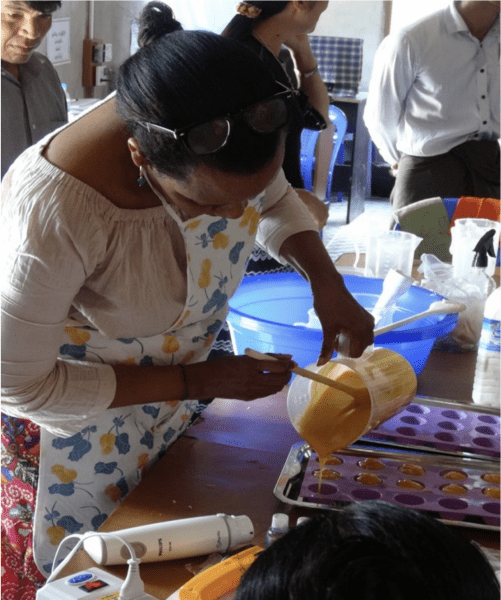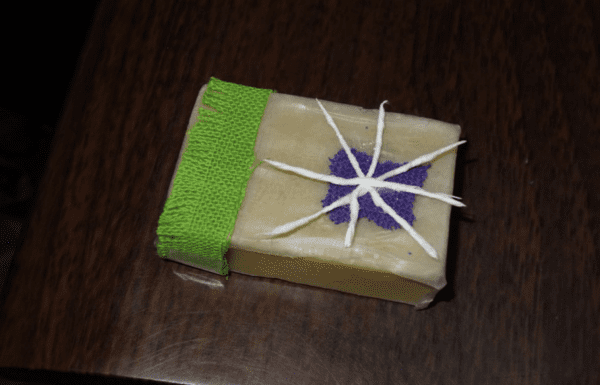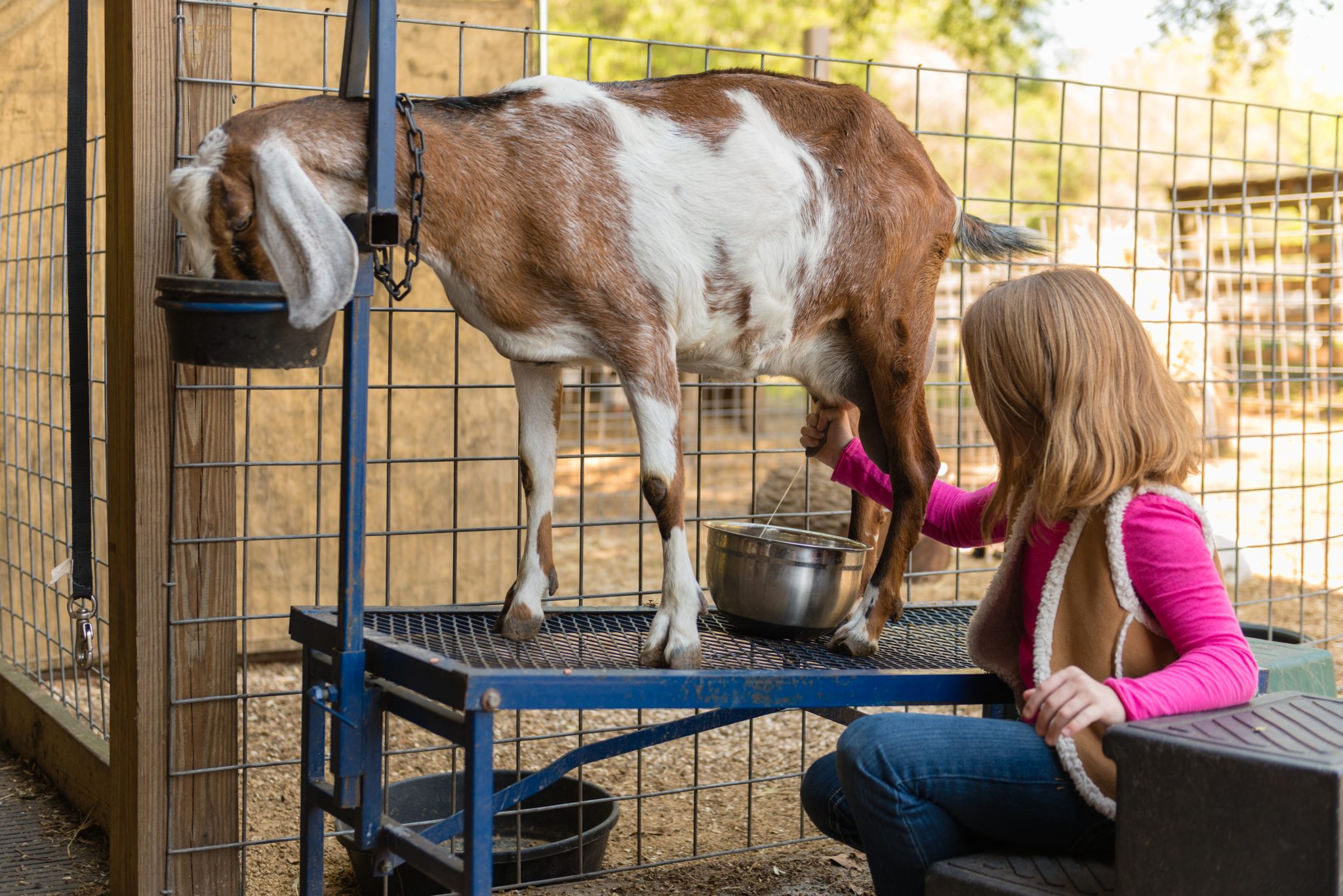Animals

Using surplus milk from goats and sheep can help to boost your personal or business revenue.
Introduction

Figure 1. Raw soap being poured into molds.
Photo Credit: Robert Spencer
Value-added products can help you to boost your business or personal revenue. For example, surplus milk from goats and sheep, whether fresh or frozen for later use, can be processed into yogurt, skin care, or utility products. If converting milk into consumables, your milk processing facilities and products may have to undergo a safety inspection. However, if you are converting dairy milk into skin care and/or utility products, it is unlikely that any inspections will have to be conducted, but you will need to use the appropriate labeling and perhaps obtain a simple business license.
Marketing and labeling value-added products will require creativity, consumer education, and product promotion. These products can be sold directly from the farm, public markets, retail stores, over the Internet, or indirectly through wholesalers. There are numerous print and digital resources to help you to create and market your value-added products.
Goat and Sheep Milk Products
The following value-added products can provide personal enjoyment, gifts to friends and family, wholesale and retail merchandise, and certainly, additional revenue.
Consumables
- Cheeses (soft-spread and aged/hard)
- Ice cream
- Yogurt
- Kefir
- Container milk
Skin care products
- Soaps (solid & liquid)
- Shampoo (liquid & solid)
- Lotion (liquid and solid)
- Lip balm (tube or container)
Utility
- Paint (white-wash paint)
- Livestock feed source
Consumables
When converting milk into consumables, skin-care, or utility products, you will need a reactionary agent or a chemical process. Either white vinegar or rennet is usually added when making cheese. While vinegar curdles the milk to make cheese, rennet contains an enzyme that converts raw milk to soft or hard cheese. For making yogurt or kefir, a healthy bacterium is added to milk that converts it into a semi-liquid stage. And milk is often pasteurized through a heating and cooling process. In addition, it’s important to know where consumables are sold to the public because you may have to adhere to extensive legal, licensing, and inspection regulations.
Skin Care Products

Figure 2. Simple yet colorful packaging for soap.
Photo Credit: Robert Spencer
To make soap and shampoo, whether in solid or liquid form, the use of oils, fats, liquids, or caustic chemicals requires a mixture of ingredients that causes a chemical reaction called saponification. Whether it be sodium hydroxide (for solid soap) or potassium hydroxide (for liquid soap), these chemicals when mixed with fats and oils will result in saponification as beautiful handmade soap or shampoo. Both hydroxides are very caustic and require special handling, equipment, and processes.
The difference between soap and shampoo is the use of vitamin E, silk protein, or other hair-enhancing ingredients to shampoo. To make lotion, you will need a modified version of wax that emulsifies oils and liquids into a viscous state that can vary from a lotion to a cream. Lotion that includes liquid milk would necessitate the use of a natural or synthetic preservative to prevent the goat milk from souring or going bad. To make lip balm, you will need wax, oils, an emulsifying agent, and powdered goat milk. Liquid goat milk would not work when making a solid form of lip balm.
Utility Products
To make a utility product such as whitewash paint, use vinegar to curdle the milk. Next add hydrated lime, filter, and add pigment if desired. The paint is non-toxic and provides a soft finish, almost antique-looking that is long lasting.
Goat or sheep milk can also be used as a livestock feed source and does not require further processing. It can be used to feed kids and lambs, young and growing pigs, calves, equine, and other livestock or orphan animals. It has a high nutritional value and is easily digested.
Labeling
Consult with your local health department, a product attorney, or the Internet when it comes to product labeling for consumable products. Regulations will vary from state to state. When labeling skin care products, consult with a producers group or association, the Internet, and/or a product attorney. Given the product is not being consumed internally the regulations are less strict. However, an entrepreneur should still try to meet all reasonable requirements for product labeling to protect yourself from potential lawsuits and/or consumer complaints. When labeling utility products, and as long as they are being utilized at home or on a farm, labeling is not required unless you wish to identify the substance in a particular container for personal or family safety reasons.
Marketing
Many value-added products can be marketed directly from the farm, at local farmers markets, public events, or retail shops. They can also be sold wholesale for retail at gift shops, consignment stores, and hotels. Marketing via social media or websites is probably one of the least expensive forms of marketing and reaches an extensive audience.
Word of mouth advertising is the most effective and the least costly form of advertising. For production promotion, it’s important to educate potential consumers on the benefits of using value-added dairy products such as these products are all natural, artisan-crafted, and made directly from the farm. Don’t forget to include personal appeal.
Resource Assessment
You can find additional information in print and digital resources regarding value-added products, including product recipes, benefits, and marketing. Entrepreneurs will need to identify credible information, affordable ingredients and production resources, and practical marketing opportunities.
Also, be sure to evaluate labor, equipment, finances, and facilities if necessary to determine which enterprise is most appropriate for you. Time constraints will also be a determining factor whether you work with 2 or 200 sheep and goats to produce, package, or market products.
Regardless if your value-added venture involves one person, other family members, or friends, each person can assume roles they feel most comfortable. Each of these small-scale enterprises has the potential to create jobs and economic impact.
Reference
WikiHow. (2019, March 29). How to make milk paint. Retrieved from https://www. wikihow.com/Make-Milk-Paint.
Meier, J. (2020, March 25). How to make homemade goat cheese with vinegar. Retrieved from https://www.thespruce.com/homemade-goat-cheese-with- vinegar-591556.
Cornelisse, S., & J. Hyde.(2017, August 14).Get more from your milk: Increasing profit through value-added dairy food products. PennState Extension. Retrieved from https://extension.psu.edu/get-more-from-your- milk-increasing-profit-through-value-added-dairy-food-products.
Download a PDF of Value-Added Products Utilizing Goat & Sheep Milk, UNP-2125.

